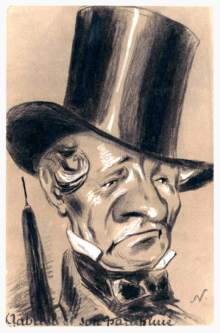Gabriel de Lurieu
Gabriel de Lurieu (real name Gabriel-Zéphirin Gonyn de Lurieu; Paris, 28 October 1799 (7 brumaire year VIII) [1] – Paris, 5 February 1889 [2]) was a French author and playwright.

He signed with Armand d'Artois and Francis de Lurieu under the collective pseudonym "Sapajou",[3] and under "J. Gabriel", "Jules", « Gabriel Lurieu » and « Monsieur Sapajou ». His brother Jules-Joseph-Gabriel Gonyn de Lurieu (1792–1869), with whom he is sometimes mistaken, was also a playwright.
Biography
The son of a captain of Dragons from a family of the minor nobility (squire) of the former Forez province, parallel to its inspector general career in the watch of Benevolent Institutions of the City of Paris, he started writing theatre plays. He authored numerous plays and libretti for opéras comiques, most of them written in collaboration, in particular with Théophile Marion Dumersan, Francis baron d'Allarde, Armand d'Artois, Nicolas Brazier, Eugène Scribe, Bernard Lopez, Élie Sauvage, Alexis Wafflard, Théodore-Ferdinand Vallou de Villeneuve, Auguste-Michel Benoît Gaudichot Masson, Adolphe Charles Adam and Emmanuel Théaulon.
In 1823, in the 7th arrondissement of Paris, he married his cousin Louise-Charlotte Gonyn de Lurieu,[4] daughter of a former officer became a magistrate.[5]
When he died, the 7 February 1889 issue of le Figaro wrote:
The death has been announced an old playwright, Gabriel de Lurieu. He was 86 years old. While spending much of his career in administration, Lurieu busied himself much with literature. From 1823 to 1858, he composed vaudeville, dramas, comic operas librettos, several of which have been successful. The most famous are Un jour à Rome, the Prise de voile, Un cordon bleu, the Pêche aux beaux-pères, the Loup de mer, Angélique et Médor, the Percherons and the Trois Nicolas.[6]
Theatre
- 1818: Les Solliciteurs et les fous, comedy in 1 act with Mélesville, Théâtre de la Porte-Saint-Martin.
- 1822: Les Blouses ou La Soirée à la mode, comédie en vaudevilles in 1 act with Achille d'Artois and Emmanuel Théaulon, Théâtre des Variétés.
- 1823: Le Gascon à trois visages, folie parade with Charles Honoré, 24 December, Théâtre de la Porte-Saint-Martin.
- 1836: La Belle Écaillère, drame vaudeville with Emmanuel Théaulon, 27 September, Théâtre de la Gaîté.
- 1837: Crouton, chef d'école ou Le Peintre véritablement artiste, tableau in 1 act mingled with couplets, with Emmanuel Théaulon and Frédéric de Courcy , 11 April, Théâtre des Variétés.
- 1837: La Dot de Cécile, vaudeville in 2 acts with Emmanuel Théaulon and Angel , 30 October, Théâtre du Palais Royal.
- 1839: Argentine with Charles Dupeuty and Michel Delaporte, Théâtre du Palais Royal.
- 1858: Les Trois Nicolas, opéra-comique in 3 acts, in collaboration with Eugène Scribe and Bernard Lopez, music by Louis Clapisson, premiered 16 December in the salle Favart.
Gabriel de Lurieu wrote the libretto for the opera La perle du Brésil by Félicien David.
In 1815, he published a short piece of vaudeville, played in October 1814 at the Théâtre du Vaudeville in Paris, entitled Le Tambour et la Vivandière. The book is available at the library of the University of Michigan.
Distinctions
- Chevalier of the Légion d'honneur (15 January 1839 decree).
- Officier of the Légion d'honneur (1 January 1853 decree).
- Commandeur of the Légion d'honneur (7 August 1869 decree).[7]
References
- Archives reconstituées de la Ville de Paris, fiche 13/101. on that file, he appears under the name Gonyn dit Lurieu
- Archives numérisées de la Ville de Paris, état-civil du 16e arrondissement, registre des décès de 1889, acte n°154, vue 22/31
- After Quérard, quoted by Centre d'Études du XIXe siècle français : Collection O'Neill-Karch, n° 215 Archived 2009-05-21 at the Wayback Machine
- died 21 decembre 1884 in Paris 8th. Archives numérisées de la Ville de Paris, état-civil du 8e arrondissement, registre des décès de 1884, act n° 1916, vue 29/31
- Archives reconstituées de la Ville de Paris, fiche n° 48/51
- "Courrier des théâtres". Le Figaro (in French). 7 February 1889. p. 3.
- Base Léonore The file bears an erroneous birth date: 1803 instead of 1799.